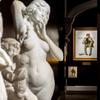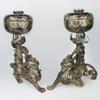Majesty, Captured: American Impressionism
- June 24, 2015 13:51
Sun-drenched landscapes. Intimate domestic scenes. Bustling cityscapes. Viewed through the canvasses of the American Impressionists, the American experience is undeniably as diverse and compelling as the American spirit itself. While the Impressionist movement began as a distinctly French style, French-trained American artists of the late nineteenth century thrived in the United States, translating the lightly brushed, dynamic canvasses of their French compatriots into a manifestly American idiom. Simultaneously nationalistic, optimistic and nostalgic, these remarkable artists captured a sense of their particularly modern moment as few have since.
Renowned American Impressionist Childe Hassam was one such artist. Settling in New York in the 1890s, many of his canvases feature lively urban scenes and towering cityscapes that capture the dynamism and liveliness of the metropolitan landscape. Yet, it was his summers traveling throughout the countryside that produced some of his finest works. Visiting remote northeastern towns, Hassam sought to find places with both a picturesque beauty and cultural significance. This dual interest is unmistakably clear in his work, Late Afternoon, Gloucester. Hassam's view of this American town is both nostalgic and vivacious. With his impressionistic gaze, he offers a glimpse that feels simultaneously timeless and fleeting, presenting a distinctly American scene in a way that no other artist of the period could achieve. An important depiction of one of Hassam's favored subjects, Late Afternoon, Gloucester undeniably stands among the masterpieces of American art.
This quintessentially American regard for landscape can also be seen in the work of celebrated American Impressionist Edmund Charles Tarbell. The highly regarded leader of a group of artists who were, in the mid-1890s, dubbed The Tarbellites, Tarbell was instrumental in pioneering a distinctly American variation of the French style of the early Impressionists. One of his most highly regarded works, A Summer Idyll, depicts his wife Emeline within an enchanting forest scene. Beautifully composed with a high vantage point, the elegant figure of Emeline is cropped slightly as she walks forward toward the viewer with a flowing stream at her back, evoking a true sense of a moment. She seems at one with the nature that surrounds her, a feeling that is strengthened by the sketch-like execution that blends the fabric of her skirts with the foliage behind her. Full of air and lightness while exuding a distinctly American spirit, this extraordinary composition is an undeniable treasure of American impressionism.
While many American Impressionists sought out the tranquility of nature for their en plein air works, the bustling cityscape also proved to be quite inspiring for many painters. Danish-American painter Johann Berthelsen's oeuvre is dedicated to poetic scenes of New York City, where he moved in 1920 to pursue an artistic career. His wintertime scene Winter in Washington Square, New York perfectly portrays the beauty and ambiance of snowfall in the city. The scene depicts Washington Square in New York City under a veil of blinding flurries, while streetcars and bundle figures battle the weather. Heavily influenced by the Impressionists of France, Berthelsen sacrifices the details of the cityscape in favor of atmosphere. The painting's blue- and grey-toned monochrome palette conveys to perfection both the coolness and peacefulness of a winter's afternoon. Bethelsen’s fascination with the city resonates through his work, and his iconic scenes such as this one are highly prized masterpieces of American Impressionism.
This desire to capture a moment, be it in the intimacy of the home, the serenity of the country or the vitality of the urban landscape, resonates through the vast oeuvre of the American Impressionists. Today, these remarkable canvasses represent an age of patriotism and hope, capturing with their swift brushstrokes American in all its youthful splendor.
About M.S. Rau Antiques:
M.S. Rau Antiques has spent over 100 years earning the trust of discerning collectors world-wide. Located in the heart of New Orleans’ historic French Quarter, our peerless showroom houses one of the world’s most extensive and stunning collections of important fine art by artists such as Monet and van Gogh, rare 18th-and 19th-century antiques and breathtaking jewelry, including rare colored diamonds.





















100x100_c.jpg)